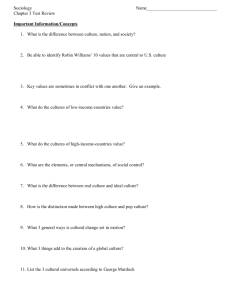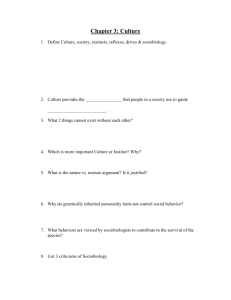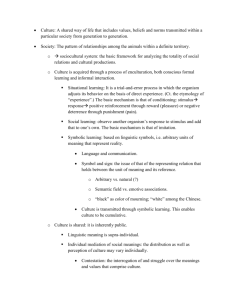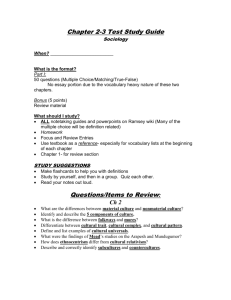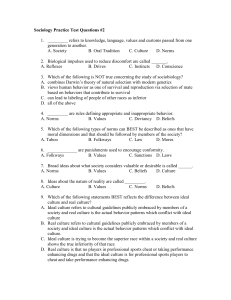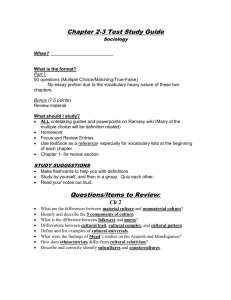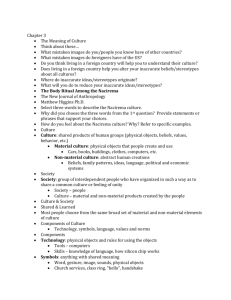Chapter 3 PPT
advertisement
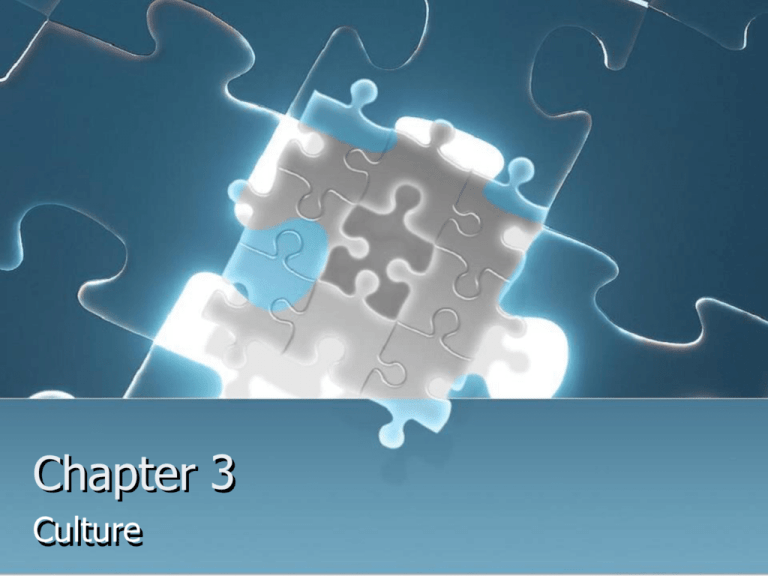
Chapter 3 Culture Section 1 THE BASIS OF CULTURE Section 1 Objective • Culture defines how people in a society behave in relation to others and to physical objects. Although most behavior among animals is instinctual, human behavior is learned. Even reflexes and drives do not completely determine how humans will behave, because people are heavily influenced by culture. • • explain how culture and heredity affect social behavior. Culture and Society Culture knowledge, values, customs and physical objects that are shared by members of a society Material side – the concrete, tangible objects of culture Nonmaterial side- ideas, beliefs Society a specific territory inhabited by people who share a common culture What 2 things can not exist without each other? • Culture • Society • These 2 are tightly interwoven. • Behavior based on culture culture is learned behavior Culture and Heredity Instincts innate (unlearned) patterns of behavior Why is culture more important than instinct in determining human behavior? How does heredity affect behavior? Reflexes automatic reaction to physical stimulus Drives impulse to reduce discomfort Which is more important? Culture or Instinct. • Culture is the more important of the 2. • It can carry us past where instinct leaves off. What is the nature vs. nurture argument? Is it justified? • How much of personality is heredity & how much of it is learned behavior? • You can justify either direction, with the right argument. Sociobiology Sociobiology the study of the biological basis of human behavior How do sociobiologists view human behavior? What are some of the criticism of sociobiology? Is there a middle ground? What behaviors are viewed by sociobiologists to contribute to the survival of the species? • Parental care & Affection • Friendship • Sexual Reproduction • Education List 3 criticisms of Sociobiology • Importance placed genetics could be used to justify races superior or inferior • To much variation in societies around the globe to base behavior solely on genetics • Use of language unique to humans, as well as the complex social life Section 2 LANGUAGE AND CULTURE Symbols, Language and Culture What are symbols? Symbols a thing that stands for or represents something else How are language and culture related? Why are symbols important? Help to create and transmit culture Make up Language Meaningful representation of something Why is language important? • Allows us to create culture • Allows us to read, discuss, & recombine existing ideas • Can pass along experiences, ideas, & knowledge What can vocab tell us about a culture? • When something is important to a society, its language will have many words to describe it. – Americans w/ Money Are we prisoners of our Language? • Exposure to other languages gives us other view points. If we only know & use 1 language we are stuck. The Sapir-Whorf Hypothesis Edward Sapir & Benjamin Whorf What can vocabulary tell you about a culture? Does the hypothesis of linguistic relativity mean we are prisoners of our language? What other factors help to shape our perception of reality? Hypothesis of linguistic relativity theory stating that our idea of reality depends largely on language Section 3 NORMS AND VALUES Norms: The Rules We Live By Norms rules defining appropriate and inappropriate behavior William Graham Sumner stated that anything can be considered appropriate when norms approve of it. Cultural Etiquette Country Custom England/Scotland & Wales Appointments are essential. You may be ten minutes late but not ten minutes early! Greece Be careful not to praise a specific object too enthusiastically or the host may insist on giving it to you. Libya If you are invited to a Libyan home for dinner, only men will be present. Take a gift for the host but not for his wife. Senegal Never eat food with the left hand, as this is considered offensive Zambia Avoid direct eye contact with members of the opposite sex—it may suggest romantic overtures Saudi Arabia It is an insult to sit in such as way as to face your host with the soles of your shoes showing. China A visit to a Chinese home is rare—unless the government has given prior approval Folkways, Mores, and Laws What are folkways? Folkways norms that lack moral significance What are mores? Mores norms that have moral dimensions and that should be followed by members of the society Taboos a rule of behavior, the violation of which calls for strong punishment How doe laws differ from mores? Law a norm that is formally defined and enforced by officials Silly Laws Still on the Books State Law Alabama It is illegal for a driver to be blindfolded while driving. Arizona Hunting camels is prohibited Florida If an elephant is left tied to a parking meter, it still has to pay the meter fee Illinois Cannot contact the police before entering the city in a car Iowa Kisses can last for up to but not longer than 5 minutes Maine You must not step out of a plane in flight Massachusetts No gorilla is allowed in the back seat of a car Minnesota You may not cross state lines with a duck on your head Vermont Whistling underwater is illegal Washington It is illegal to pretend your parents are rich List some examples of folkways. • Supporting a school activity • Speaking to others in passing • Removing your hat while inside a building – See the chart on pg. 82 • Failure to do these draws no real punishment, but you do these as a sign of politeness. How are mores different from folkways? Conformity draws strong social approval, violation brings strong disapproval Why are the punishments for taboos so strong? Because the feelings against these are so strong some believe punishment will come from the supernatural Cite the differences between Folkways/Mores • Emerge slowly & are often created unconsciously Laws • Consciously create & enforce (usually don’t change) How are sanctions used to shape behavior? Rewards are used to encourage appropriate behavior while punishment reinforces that the behavior is unacceptable How have American norms change in relation to values? • Racism on decline • People working as hard at leisure activities as the do at work • Increased emphasis on honesty & friendliness Enforcing the Rules Sanctions rewards and punishment used to encourage people to follow norms What are formal sanctions? Formal sanctions sanctions imposed by persons given special authority What are informal sanctions? Informal sanctions rewards or punishments that can be applied by most members of a group Values– Basis for Norms What are values? Values- broad ideas about what is good or desirable shared by people in a society Why are values important? List some norms in American life. List 5 and explain each of them Basic Values in the United States Sociologist Robin Williams (1970) identified important US values: 1. Achievement & success 2. Activity & work 3. Efficiency & practicality 4. Equality 5. Democracy 6. Group superiority Section 4 BELIEFS AND MATERIAL CULTURE Beliefs and Physical Objects Nonmaterial culture - ideas, knowledge, and beliefs that influence people’s behavior Why do beliefs matter? What is material culture? Beliefs- ideas about the nature of reality Material culture - the concrete, tangible objects of a culture How is material culture related to nonmaterial culture? T/F beliefs can be based on false thoughts? True Check out this picture and think about some others Why is the cultural meaning of physical objects not determined by physical characteristics? • Meaning of physical objects are based on beliefs, norms, & values people hold with regard to them Ideal and Real Culture Ideal Culture cultural guidelines that group members claim to accept Real Culture actual behavior of members of a group Using the topic of honesty, cite an example of ideal vs. real culture. Section 5 CULTURAL DIVERSITY & SIMILARITY Cultural Change Why does culture change? 1. Discovery 2. Invention 3. Diffusion What are 3 reasons cultures change? • Discovery process of finding something already in existence What are 3 reasons cultures change? • Invention creation of something new What are 3 reasons cultures change? • Diffusion borrowing aspects of culture from other culture Cultural Diversity Social categories groupings of persons who share social characteristics What are subcultures and countercultures? Subculture a group that is part of the dominant culture but that differs from it in some important respects Counterculture a subculture deliberately and consciously opposed to certain central beliefs or attitudes of the dominant culture Give an example of a subculture & reasons why? • Chinatown American culture effected greatly; but have retained things such as language, diet, & family structures Why is “Punk” considered a counterculture? Rebellion against social norm of thinking, dress, behavior, & sexuality Ethnocentrism Ethnocentrism judging others in terms of one’s own cultural standards What are some examples of ethnocentrism? Does ethnocentrism help or hurt society? Why are the Olympics seen as ethnocentric? • Country’s medal standing is taken as a reflection of their worth & status on the world stage Give the “Pros” & “Cons” of ethnocentrism. Pro • Postive feelings when what they do is right or superior • Stability due to tradition & valued behavior Con • Complacency (not ingenuity) • Violence against others due to lack of understanding Cultural Universals Cultural Universals general cultural traits that exist in all cultures How are cultural universals expressed? Cultural particulars the ways in which a culture expresses universal traits Why do cultural universals exist? List some cultural universals • Sports/ cooking/ courtship/ education/ family/ government/ joking/ language/ mourning & marriage/ music/ sexual restrictions What 3 things cause cultural universals? • Biological similarities • Physical environment • Face same social problems Cultural Universals Researchers have identified more than 70 traits in all cultures Economy Clothing, Food, Shelter, Communications, Transportation, Business, Jobs, Services, Goods, Technology, Tools, Trade Institutions Economy, Religion, Education, Government, Family Arts Folk Tales, Crafts, Music, Theater, Dance, Literature, Art Language Environment Recreation Beliefs Words, Expressions, Pronunciations, Alphabet, Symbols Communities, Geography, Geology, Habitat, Wildlife, Climates, Resources Games, Toys, Arts, Media, Holidays, Festivals Values, Traditions, Ethnicity, Customs, Religions, Morals
